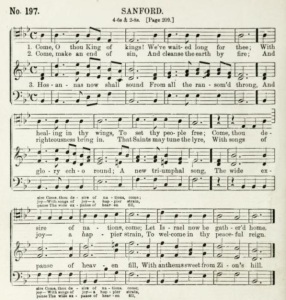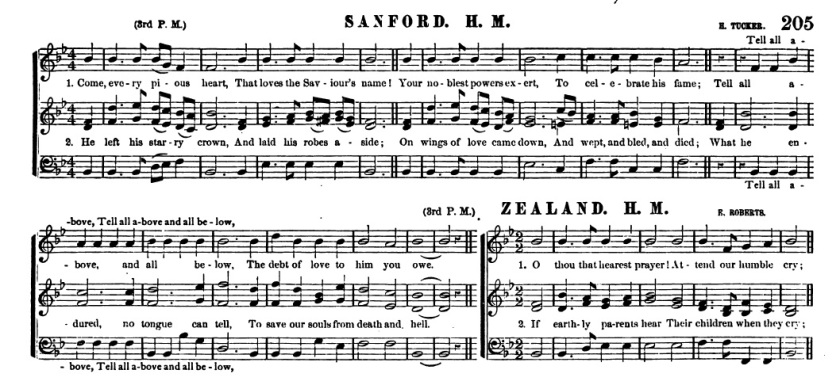“Come, O Thou King of Kings” (Hymn no. 59), long-attributed to Parley P. Pratt, was first published anonymously in May 1840, in the first issue of the Latter Day Saints’ Millennial Star. From there, it entered Latter-day Saint hymnody in A Collection of Sacred Hymns, for the Church of Jesus Christ of Latter-day Saints, in Europe (1840), and has been included in every subsequent hymnal to the present. The earliest Latter-day Saint hymnals do not include musical notation and therefore it is not known to which tune this hymn was sung in the early days of the Church.

The Latter-day Saints’ Psalmody, published in 1889, is the first official Latter-day Saint hymnal to include music, and in this book these words were paired with a tune named SANFORD, which remains the tune to which we sing them today. The composer of SANFORD is listed in the current Latter-day Saint hymnal as “Anon., ca. 1889.”
The Latter-day Saints’ Psalmody was an extremely influential collection, and many of the musical settings originating in this book are still in use by the Latter-day Saints. In fact, many of the tunes in the current hymnal owe their names to the editors of the Psalmody. Borrowed tunes were often renamed, most likely when the original tune name was unknown. Thus the tune for “The Spirit of God” was named ASSEMBLY; “Praise to the Man” became MARTYR; and Caroline Norton’s “The Officer’s Funeral” (“We Thank Thee, O God, for a Prophet”) was called FOWLER. These names are still used to identify these tunes in the 1985 hymnal.
Other borrowed tunes were renamed for the Psalmody, but have since been restored to their original tune names. These include DUANE STREET (“A poor wayfaring man of grief), known as HYRUM in the Psalmody, OAKEN BUCKET (“Do what is right”), which appeared as DAWNING, and LION OF JUDAH (“Now let us rejoice”) which was renamed PHELPS.
Some of the borrowed tunes, however, kept their original tune names. Fortunately, SANFORD was one of these hymns, and this enabled a composer’s name to be found. A search through various hymnals uncovered a tune named SANFORD in the index of an 1868 collection entitled The Tonart.

In The Tonart, SANFORD appears in an identical arrangement as the one found in the Psalmody, and the composer is listed as “H. Tucker,” presumably Henry Tucker (1826-1882), the popular nineteenth-century songwriter who also composed LION OF JUDAH, the musical setting for “Now Let Us Rejoice” (Hymn no. 3). It is not known if the tune SANFORD appears in any other hymnals.
Little is known concerning the life of Henry Tucker. He was born William Henry Tucker on December 13, 1826 in Kingston, Ontario, Canada. His parents, whose names are unknown, moved to Canada from Connecticut prior to his birth.
Tucker was raised in Auburn, New York, where he received his education. “In childhood he displayed a remarkable predilection for music and an aptitude for performing on every musical instrument he could get access to.” (New York Sun). Nothing else is known of his early life.
Tucker resided in Geneva, New York from 1848 to 1850, and was the organist at the Reformed Dutch Church in that city. The first of his many musical compositions were published around this same time, and in 1851 he enjoyed modest success with “The Kingston Waltz,” published by Firth, Pond, and Company, a music publishing firm located in New York City.
Shortly afterward Tucker moved to Albany, New York, and served as the musical director of the Albany Mendelssohn Union. He married Mary Rebecca Strong in 1854. Around 1860 he moved with his family to New York City, and they eventually made their home in Brooklyn.
Tucker supplemented what little income he made from his compositions by teaching music. “He gave lessons on almost every musical instrument, but more especially on the piano, organ and guitar.” (Sun) He also worked as a piano tuner. “Wherever and whenever he was seen his coat pockets bulged with a roll of piano strings and two or more huge tuning keys.” (Cooper)
Tucker was the organist at several of the New York City churches, and was for many years organist at the Hanson Place Baptist Church in Brooklyn. He also volunteered his time teaching music at the Home of Industry and Truant Institution (also known as the Truant Home).
“When variety entertainments first came in vogue in [New York City] he furnished music for many of the ballads written by George Cooper,” wrote the editor of the New York Sun. “Eva Brent, a popular ballad singer of that time, sang only Mr. Tucker’s compositions. After her death he used to say that no one but she had ever done them justice.” (Sun)
Tucker composed many different types of songs, including hymns, marches, keyboard dances, and one cantata, “Joseph in Egypt” (with words by George Cooper), but it is his popular songs for which he is best remembered. His most popular compositions include “Weeping, Sad and Lonely, or When this Cruel War is Over,” “Dear Mother, I’ve Come Home to Die” and “Sweet Genevieve.” “When this cruel was is over,” one of the most popular Civil War songs, sold more than a million copies, but earned Tucker only $1,000 due to copyright infringement.
Tucker was always insecure about his physical appearance, due to a childhood injury to one of his feet that made it necessary for him to walk with a cane. “Crippled from birth, he felt his bodily infirmities most keenly, imagining that they dwarfed him in the estimation of the refined, and very often he would yield to fits of melancholy.” (Cooper). Despite this, “his conversation was bright and witty, and his company was much sought.” (Sun)
Henry Tucker died in Brooklyn, New York, on February 10, 1882, at the age of 55. He was interred at Cypress Hills Cemetery. He was survived by his wife and three daughters: Myra Tucker Davis (1855-1924), Lillias L. Tucker Whitlock (1856-1932), and Mabel Dennis Wilke (1863-1930). Tucker was also the father of a son, Lyman (ca. 1860), who died in early childhood.
Update 11/9/2020:
Genealogist Thomas W. Jones has done extensive research on the life and ancestry of Henry Tucker, who was a first cousin of his great-great-grandfather George M. D. Tucker. In an article published last October (2019) in the New York Genealogical and Biographical Record, Jones confirms that Henry Tucker’s full name was William Henry Tucker, and establishes his parents’ names as Benjamin Tucker (1796-1828) and Matilda (Parker) Tucker (1799-1875). He also clarifies that the cause of death listed on Tucker’s death certificate is heart disease, rather than a “brain affection” as reported in the newspapers. Jones also discovered a “Family Record” for Benjamin Tucker amid some pension and bounty land application files (for the exact file name and location, see p. 262, note 17), which lists the date of birth of his son Henry Tucker as December 13, 1825 (rather than 1826).
See Thomas W. Jones, “Henry Tucker (1825-1882): Composer of an Erstwhile ‘Most Popular Song Ever Written in America,’” New York Genealogical and Biographical Record 150, no. 4 (October 2019): 261-277. According to the editor, “Thomas W. Jones cleared up what he called the ‘murky’ origin of Henry Tucker, who composed a Civil War-era song that was once considered the ‘most popular song ever written in America.’ A grave marker and a will helped establish the names of Henry’s parents, clearing a path for further study. Jones’s article memorializes Henry and his family, a fitting tribute to a nineteenth-century composer whose music is still enjoyed today.”
Notes:
There are no known photographs of Henry Tucker, but his physical appearance has been described as follows:
“Prof. Tucker, as he was usually called, was below the medium height, and inclined to stoutness. Owing to an injury to one of his feet, received in childhood, he was compelled to walk with a cane. He had a large head and a projecting brow.” (Sun)
.
Sources:
“Second Advent,” Millennial Star, May 1840, 24.
Edward Roberts and John P. Morgan, eds., The Tonart: A Collection of Sacred and Secular Music, comprising Hymn Tunes, in Every Variety, Anthems, Glees, and Social Songs: Together with a complete elementary Department, designed for the use of Choirs, Singing Schools and the home circle (New York: F. J. Huntington & Co., 1868), 205.
“The Truant Home,” Brooklyn Daily Eagle, September 6, 1860, [3].
“The Truant Home,” Brooklyn Daily Eagle, December 13, 1860, [2].
“Card,” Brooklyn Daily Eagle, February 23, 1863, [7].
“Personal,” Philadelphia Inquirer, November 17, 1876, 4.
“Henry Tucker,” Brooklyn Union Argus, Feb 13, 1882.
“The Death of Henry Tucker,” New York Sun, February 13, 1882, [1]
“Funeral of Henry Tucker,” Morning Oregonian, February 14, 1882, [1].
“Death of Henry Tucker, the Composer,” Geneva (New York) Gazette, February 17, 1882, [2].
George Cooper, “Henry Tucker,” J. W. Pepper Piano Music Magazine, June 1902, n. p.
“Obituary” (Mary Rebecca Strong Tucker), Brooklyn Daily Eagle, January 9, 1905, 5.
Russell Sanjek, American Popular Music and Its Business: The First Four Hundred Years, Volume II, From 1790 to 1909 (New York: Oxford University Press, 1988), 246.
Nicholas E. Tawa, “Tucker, Henry,” in New Grove Dictionary of American Music, vol. 4, ed. H. Wiley Hitchcock and Stanley Sadie (London: MacMillon, 1986), 415-16.
“New York State Census, 1855,” database with images, FamilySearch (https://familysearch.org/ark:/61903/1:1:K63Q-ZQG : 13 March 2018), Wm H Tucker, Ward 5, Albany City, Albany, New York, United States; citing p. 43, line #42, family #288, county clerk offices, New York; FHL microfilm 521,922.
“United States Census, 1860,” database with images, FamilySearch (https://familysearch.org/ark:/61903/1:1:MCW6-S2Y : 12 December 2017), Henry Tucker, New York, United States, citing p. 80, family 587, NARA microfilm publication M653 (Washington D.C.: National Archives and Records Administration, n.d.); FHL microfilm 803817.
“New York State Census, 1865,” database with images, FamilySearch (https://familysearch.org/ark:/61903/1:1:QVNJ-18B8 : accessed 27 January 2019), William H Tucker, Ward 11, Brooklyn, Kings, New York, United States; citing source p. 9, line 8, household ID 65, county clerk, board of supervisors and surrogate court offices from various counties. Utica and East Hampton Public Libraries, New York; FHL microfilm 1,930,207.
“United States Census, 1870,” database with images, FamilySearch (https://familysearch.org/ark:/61903/1:1:M8NX-QP3 : 12 April 2016), Henry Tucker, New York, United States; citing p. 179, family 1332, NARA microfilm publication M593 (Washington D.C.: National Archives and Records Administration, n.d.); FHL microfilm 552,450.
“New York, New York City Municipal Deaths, 1795-1949,” database, FamilySearch (https://familysearch.org/ark:/61903/1:1:2WKW-XX7 : 10 February 2018), Henry Tucker in entry for Lillian L. Whitlock, 23 Feb 1932; citing Death, Brooklyn, Kings, New York, United States, New York Municipal Archives, New York; FHL microfilm 2,069,789.